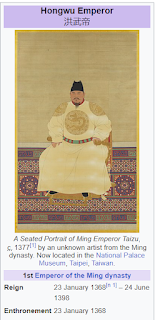Ming dynasty
Yuanzhang (1328–1398)—overthrew the Yuan, and Zhu established a dynasty he named Da Ming (“Great Brightness”). The only emperor in China’s long history to have been born to a peasant family, Zhu had been orphaned early in life.
The Great Ming, was an imperial dynasty of China, ruling from 1368 to 1644 following the collapse of the Mongol-led Yuan dynasty. The Ming dynasty was the last orthodox dynasty of China ruled by the Han people, the majority ethnic group in China, thenative Chinese rule between eras of Mongol and Manchu dominance, respectively.
During the Ming period, China exerted immense cultural and political influence on East Asia and the Turks to the west, as well as on Vietnam and Myanmar to the south during which China’s population would double. Known for its trade expansion to the outside world that established cultural ties with the West, the Ming Dynasty is also remembered for its drama, literature and world-renowned porcelain.
Ming dynasty founder Emperor Taizu, lived in Buddhist monastery in his youth, and his rise and reigned for 30 years. After established Nanjing as his capital. However, nearly fifty years later, the third Ming emperor relocated the capital to Beijing.
The Ming Dynasty had a total of sixteen emperors with almost three hundred-year span witnessed unprecedented economic fit with the teachings of Confucianism, Buddhism, and Daoism. Commoners and emperors alike supported temples and honored devotional images in their homes. As a result of cultural achievements and economic achievements, the Ming saw a larger consumer base for luxury goods than any earlier period. With refurbishment of the Great Wall , large naval expeditions, maritime trade, and the rise of a monetized economy.



Comments
Post a Comment